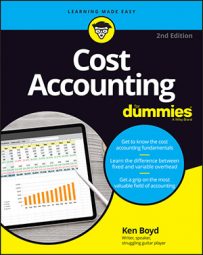When cost accounting, you put together your budgeting process for indirect costs with a plan for direct costs. Think of the combined process as normal costing. This is an important point: You trace direct costs and allocate indirect costs.
Normal costing combines indirect cost rate with actual production. The process gets you closer to actual total costs for your product.
Here are the two steps to implement normal costing:
- Direct costs: Traced to the cost object by multiplying (actual prices/rates) x (actual quantity for a specific job object)
- Indirect costs: Allocated to the cost object multiplying (predetermined or budgeted indirect cost rate) x (actual quantity for a specific job object)
Note that both direct and indirect costs use actual quantity in the formula. While you come up with an indirect cost rate in planning, the rate is multiplied by actual quantities. In this case, the quantity is jobs for the month.
A job cost sheet lists every cost you’ve incurred for a particular job. That includes direct material, direct labor, and all indirect costs. The job cost sheet is your basis for computing your sale price and your profit. You use this document to prepare a cost estimate for a client. Here is a job cost sheet using normal costing for a landscaping job.
Normal Job Cost Sheet — Landscaping Job
| Type of Cost | Amount or Quantity | Price or Rate | Total Cost (Rounded) |
|---|---|---|---|
| Direct material | 100 square feet of grass seed | $12 per square foot | $1,200 |
| Direct labor | 15 hours of labor | $15 per hour | $225 |
| Mileage | 30 miles driven | $0.18 per mile | $5 |
| Indirect costs | 30 miles driven | $5.36 per mile | $161 |
| Total job costs | $1,591 |
The indirect cost calculation (vehicle and equipment costs) uses the actual quantity (miles driven) and the estimated rate per mile. The other direct costs on the job sheet use actual quantities and actual prices/rates.

